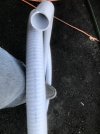A
deck drain hose, sometimes referred to as a scupper hose, is a component commonly used in boating and marine applications. It serves the purpose of draining water from the deck or other areas of a boat, usually overboard, to prevent water accumulation and potential damage.
Here are some key points about deck drain hoses:
1. Material: Deck drain hoses are typically made of durable, flexible materials like rubber, PVC, or other plastics. These materials are chosen for their resistance to saltwater, UV rays, and other environmental factors that boats are exposed to.
2. Size: The size of a deck drain hose can vary, and it's often chosen based on the specific requirements of the boat. Common diameters range from 1 inch to 4 inches or more, depending on the volume of water that needs to be drained.
3. Length: Deck drain hoses come in various lengths to accommodate different boat sizes and configurations. They can be cut to the desired length to suit the specific installation.
4. Fittings: Many deck drain hoses come with fittings or adapters on one or both ends to facilitate connections to scuppers, deck drains, or other drainage systems on the boat.
5. Installation: Deck drain hoses are typically installed to route water from the deck or other areas to a location where it can safely drain overboard. Proper installation ensures that water is effectively removed from the boat, preventing flooding or damage.
6. Maintenance: Regular maintenance is essential to ensure that deck drain hoses remain in good working condition. Check for cracks, wear, or blockages, and replace or clean hoses as needed.
7. Compliance: In some cases, there may be specific regulations or guidelines governing the installation and use of deck drain hoses on boats, especially for larger vessels and commercial vessels. It's important to ensure compliance with any relevant standards.
Deck drain hoses are crucial for the safety and functionality of boats, as they help prevent standing water on the deck, which can lead to slippery surfaces, damage, and instability. Proper maintenance and inspection of these hoses are important for the safety of the vessel and its occupants.




